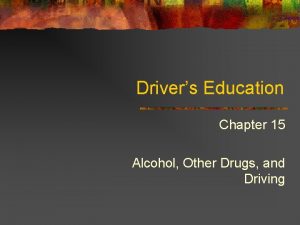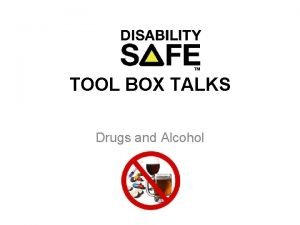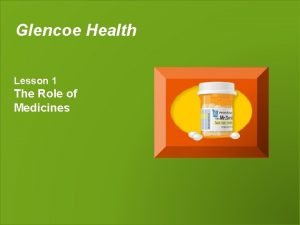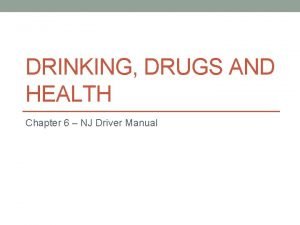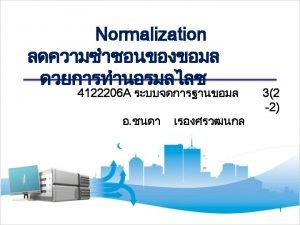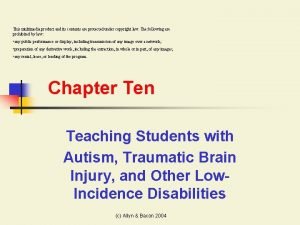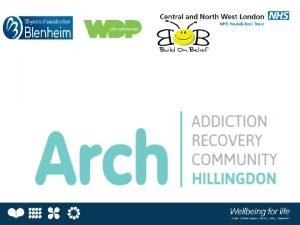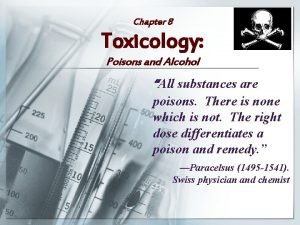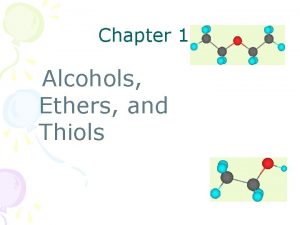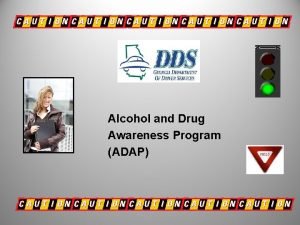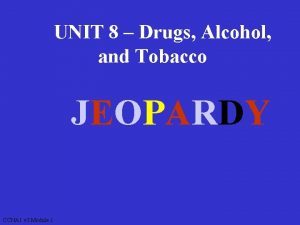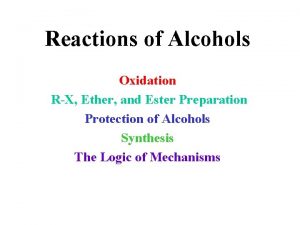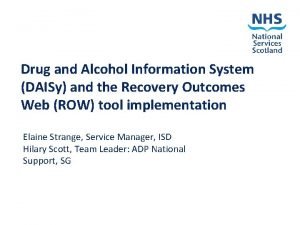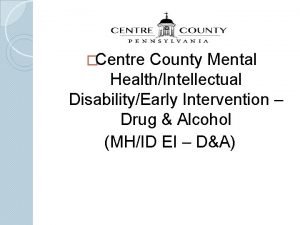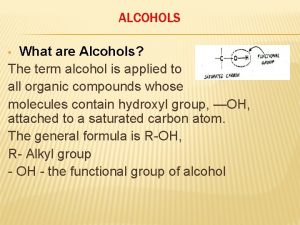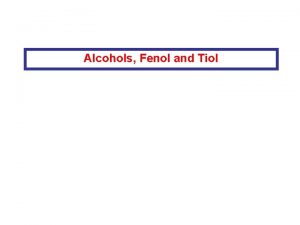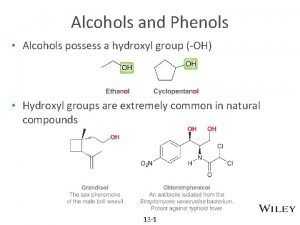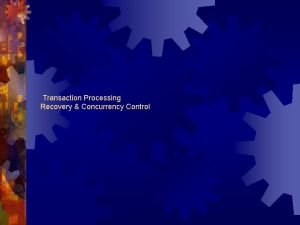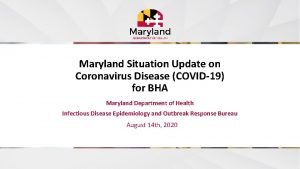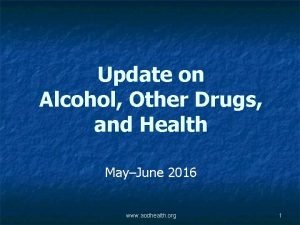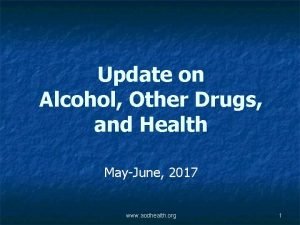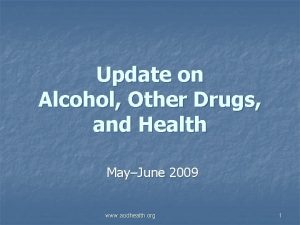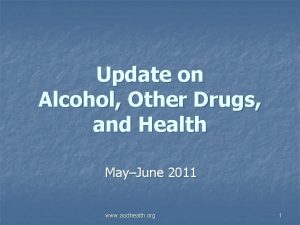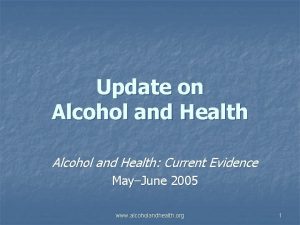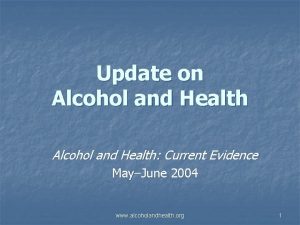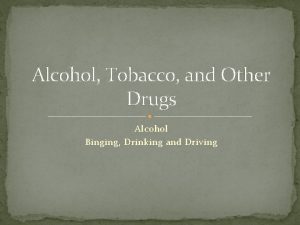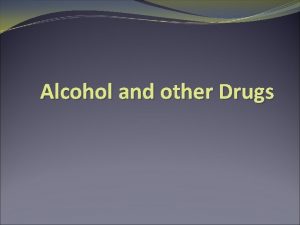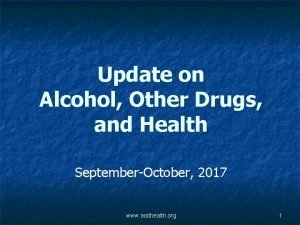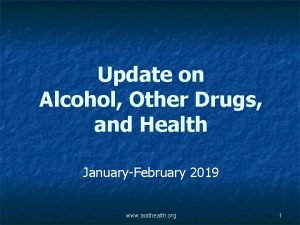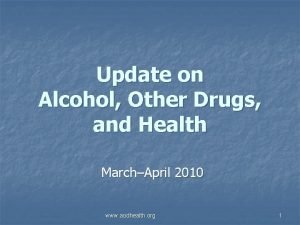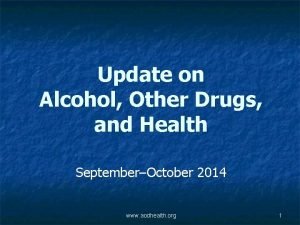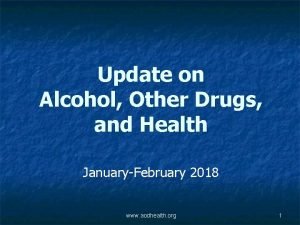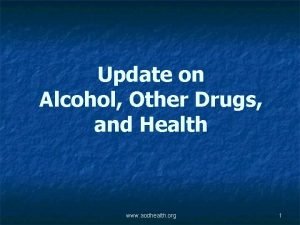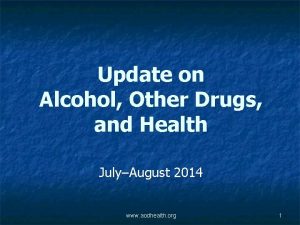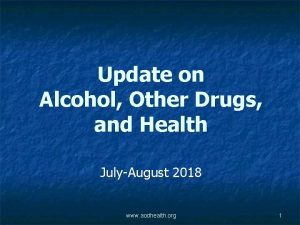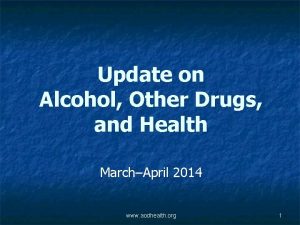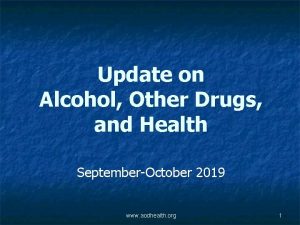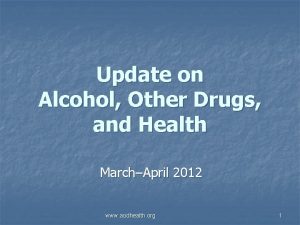Update on Alcohol Other Drugs and Health MayJune
























































- Slides: 56

Update on Alcohol, Other Drugs, and Health May-June 2018 www. aodhealth. org 1

Studies on Interventions & Assessments www. aodhealth. org 2

Can Treatment of Alcohol Use Disorder in Primary Care Be Effective? Bradley KA, et al. JAMA Intern Med. 2018; 178(5): 613– 621. Wallhed Finn S, et al. Alcohol. 2018 [Epub ahead of print]. doi: 10. 1093/alcalc/agx 126. Summary by Richard Saitz, MD, MPH www. aodhealth. org 3

Objectives/Methods n n Many patients in primary care recognized as having alcohol use disorder (AUD), but do not receive treatment for it. Two randomized studies inform us about the promise of starting AUD treatment in primary care settings. www. aodhealth. org 4

Results, study 1 n n Bradley et al assigned 304 patients with heavy drinking (73% with AUD, heavy drinking on 61% of days) at 3 US Veterans Affairs clinics to usual care, or to alcohol nurse care management that included repeated brief motivational counseling, medication, and shared decision making about treatment options. Intervention group patients were more likely to receive medication for AUD (32% versus 8%), but the pastmonth proportion of heavy drinking days was similar in both groups (39% and 35%). www. aodhealth. org 5

Results, study two n n n Wallhed Finn et al assigned 288 patients in Sweden with DSM-IV alcohol dependence (reporting 12 heavy drinking days per month) to primary or specialist care. Primary care physicians had 1 day of training, and with shared decision making, counseled, prescribed medication, or both. Patients in both groups most commonly received both treatments. At 6 months, the reduction in alcohol use (~140– 160 g per week) was similar in both groups – it was not statistically different, though it also did not meet non-inferiority criteria. www. aodhealth. org 6

Comments n n Treatment of AUD in primary care, based in shared decision making, can have similar effectiveness as treatment in specialty care settings, at least for some patients. However, improving care processes (e. g. , medication prescription) modestly may not be enough to improve clinical outcomes. As with any other condition, treating AUD is better than not treating it. But we need ways to get more people on effective treatments if we want to make a difference for patients with greater severity. www. aodhealth. org 7

The Effectiveness of Naltrexone for Alcohol Use Disorder May Be Limited to Those Who Also Use Nicotine Anton RF, et al. Alcohol Clin Exp Res. 2018; 42(4): 751– 760. Summary by Darius A. Rastegar, MD www. aodhealth. org 8

Objectives/Methods n n n Naltrexone has been shown to be an effective treatment for alcohol use disorder, but it is not effective for everyone and there may be other factors that account for some of the variation in response. There has been interest in genetic polymorphisms, particularly polymorphisms of the mu opioid receptor gene, OPRM 1. Moreover, observational data suggest that people who use nicotine may benefit more from naltrexone. www. aodhealth. org 9

Objectives/Methods, cntd. n n In this study, researchers conducted a secondary analysis of data from a study evaluating the differential effect of naltrexone by OPRM 1 polymorphisms to investigate the role of nicotine use on treatment response. Participants (N=146; 88 with nicotine use) who met criteria for DSM-IV alcohol dependence were stratified by polymorphisms and randomly assigned to naltrexone or placebo and followed for 16 weeks. www. aodhealth. org 10

Results n n n Participants who used nicotine had more drinks per day and drinks per drinking day at baseline, compared with those who did not. The primary outcome measure, percentage of heavy drinking days, was significantly reduced in the naltrexone group among participants who used nicotine, but not among those who did not. Other alcohol consumption variables similarly showed a beneficial effect of naltrexone limited to participants with nicotine use. www. aodhealth. org 11

Comments n n This study suggests that nicotine use might be a factor to consider when choosing pharmacotherapy for alcohol use disorder. The reason for this is not clear; the authors hypothesize that the dopamine release caused by nicotine may make these individuals more sensitive to naltrexone’s effect. www. aodhealth. org 12

Varenicline Reduces Smoking, May Reduce Alcohol Use, Among People With Alcohol Use Disorder Who Smoke O’Malley SS, et al. JAMA Psychiatry. 2018; 75(2): 129– 138. Hurt RT, et al. Drug Alcohol Depend. 2018; 184: 12– 17. Summary by Darius A. Rastegar, MD, Kevin L. Kraemer, MD, MSc, Richard Saitz, MD, MPH www. aodhealth. org 13

Objectives/Methods n n Varenicline is effective for tobacco cessation; some preliminary research suggests that it may help with alcohol use disorder as well. Two clinical trials addressed these questions. www. aodhealth. org 14

Results, study one n O’Malley et al randomized 131 people with DSM-IV alcohol dependence and smoking who were seeking treatment for alcohol use to varenicline or placebo and followed them for 16 weeks. n n n The primary outcomes—percentage of heavy drinking days (PHDD) and no heavy drinking days (NHDD) during weeks 9– 16 —were not significantly different between the two groups. Varenicline did result in significantly greater abstinence from smoking during the last 28 days of treatment (13% versus 0%, respectively). In secondary analyses, varenicline was associated with a significantly greater decrease in PHDD among men, but not among women, in the study. www. aodhealth. org 15

Results, study two n Hurt et al randomized 33 adults with DSM-IV alcohol abuse or dependence and smoking to varenicline or placebo for 12 weeks. n n n Participants were primarily male, white, and middle-aged. Seven-day smoking abstinence was more common in the varenicline group at 12 weeks (44% versus 6% in the placebo group). Participants in the varenicline group reported 2. 8 fewer drinks per drinking day on average at 12 weeks. There were no significant differences between groups in drinks per day, drinking days, or heavy drinking days. www. aodhealth. org 16

Comments n n These studies suggest that varenicline is effective for tobacco cessation, even among those with alcohol use disorder not seeking treatment for smoking. The effects on alcohol use appear to be smaller and inconclusive. www. aodhealth. org 17

Studies on Health Outcomes www. aodhealth. org 18

Alcohol Use Disorder Associated With an Increased Risk of Dementia Schwarzinger M, et al. Lancet Public Health. 2018; 3(3): e 124–e 132. Summary by Nicolas Bertholet, MD, MSc www. aodhealth. org 19

Objectives/Methods n To examine the association between alcohol use disorder (AUD) and risk of dementia, this study used a nationwide retrospective cohort of all adults aged ≥ 20 years admitted to a hospital in metropolitan France between 2008 and 2013. www. aodhealth. org 20

Objectives/Methods, cntd. n n Researchers also examined subtypes of dementia: early onset dementia (defined as diagnosis before age 65), alcohol-related brain damage, vascular dementia, and other dementia (including Alzheimer’s disease). Covariates were: vascular risk factors, presence of cerebrovascular disease or cardiovascular disease, education level, depression, hearing loss, visual impairment, sleep apnea, and diseases likely to lead to rare forms of dementia (e. g. uremia). www. aodhealth. org 21

Results n n AUD was associated with an increased risk of dementia (hazard ratio [HR], 3. 34 for women and 3. 36 for men); those HRs were higher than those for any other risk factor (e. g. high blood pressure [HR, 1. 43 for women and 1. 35 for men]). AUD was associated with an increased risk of each dementia type. Of the 57, 353 (5%) cases of early onset dementia, most were either alcohol-related by definition (i. e. , alcohol brain damage, 39%) or had a diagnosis of AUD (18%). www. aodhealth. org 22

Comments n n In contrast with studies suggesting potential benefits of light drinking, this study adds to the evidence of a detrimental effect of alcohol on brain function. Alcohol use disorder was the strongest potentially modifiable risk factor of dementia in this study; these results suggest a burden of dementia attributable to alcohol more important than previously thought. www. aodhealth. org 23

Youth With Inflammatory Bowel Disease Perceive Marijuana Use as Beneficial Hoffenberg EJ, et al. J Pediatr 2018 [Epub ahead of print]. doi: 10. 1016/j. jpeds. 2018. 03. 041. Summary by Sharon Levy, MD, MPH www. aodhealth. org 24

Objectives/Methods n n n Marijuana use during adolescence is associated with known harms, while the benefits of marijuana use for youth with medical conditions are to-date unsubstantiated. As more states permit medical use of marijuana, the perceived risk of harm is plummeting. Researchers examined rates and reasons for marijuana use and perceived risk of harm among 99 youth aged 13– 23 being treated for inflammatory bowel disease in Colorado. www. aodhealth. org 25

Results n n n 32% of youth endorsed lifetime marijuana use and 9% endorsed daily or near daily use. 57% endorsed at least one medical reason for use. Compared with youth without marijuana use, those who used marijuana were 10. 7 times more likely to perceive low risk of harm with regular use. www. aodhealth. org 26

Comments n n n The science behind medical marijuana is trailing far behind rapidly evolving policy and its attendant impact on public opinion. The medicalization of marijuana, which can facilitate widespread access and encourage more regular and heavy use, may serve as a disincentive to the development of more appropriate cannabinoid therapeutics. This outcome is a substantial disservice to those who could potentially benefit most from cannabinoids. www. aodhealth. org 27

Excess Fatal Opioid Overdose in the US Is Highest Among Individuals Born 1949– 1964 and 1979– 1990 Huang X, et al. Am J Public Health. 2018; 108: 131– 136. Summary by Kevin L. Kraemer, MD, MSc www. aodhealth. org 28

Objectives/Methods n n n Although prescription opioid and heroin use have adverse consequences for all age groups, it is not known if specific birth cohorts have greater risk than others. Researchers used National Center for Health Statistics data to compare opioid overdose mortality between 1999 and 2014 among birth cohorts defined by 2 -year intervals, starting with 1935– 1936 and ending with 1997– 1998. People ≤ 16 and ≥ 66 years were excluded due to a low number of overdose deaths. www. aodhealth. org 29

Results n Compared with the 1977– 1978 (approximately 21– 36 years old) birth cohort, individuals born between 1949 and 1964 (approximately 35– 65) had a 12– 27% increase in prescription opioid overdose mortality (highest risk in 1955– 1956 cohort: relative risk [RR], 1. 27) and a 7– 33% increase in heroin overdose mortality (highest risk in 1953– 1954 cohort: RR, 1. 32). www. aodhealth. org 30

Results, cntd. n Compared with the 1977– 1978 birth cohort, individuals born between 1979 and 1990 had a 5 – 16% increase in prescription opioid overdose mortality (highest risk in 1985– 1986 cohort: RR, 1. 16) and a 13– 23% increase in heroin overdose mortality (highest risk in 1989– 1990 cohort: RR, 1. 23). www. aodhealth. org 31

Comments n n These national data suggest excess prescription opioid and heroin overdose mortality among Baby Boomers and Millennials. While it is useful to know which birth cohorts are at increased risk of adverse outcomes, it is not clear that public health and clinical interventions targeted to these specific demographic groups would be more effective or necessary than universal interventions. www. aodhealth. org 32

Studies on HIV and HCV www. aodhealth. org 33

Limited Integration of HIVrelated Services in Buprenorphine Treatment Knudsen HK, et al. Subst Abuse Treat Prev Policy. 2017; 12: 37. Summary by Jessica L. Taylor, MD www. aodhealth. org 34

Objectives/Methods n n n People with opioid use disorder (OUD) are at high risk of HIV acquisition and transmission, but HIV services are not well integrated into OUD care overall. Researchers conducted qualitative interviews of buprenorphine experts (n=21) and evaluated mailed surveys of other buprenorphine prescribers (n=1174) to explore the delivery of HIV risk assessment, education, and testing in buprenorphine treatment settings. Physicians were classified as addiction specialists (including internal medicine and psychiatry; 26%), general psychiatrists (27%), or other (e. g. , internal medicine, family medicine; 51%). www. aodhealth. org 35

Results n n Although 62% of physicians reported that they provided HIV education, just 53% recommended HIV testing for all new patients and only 32% offered on-site testing. Qualitative interviews revealed that physicians may overvalue the presence or absence of injection use in determining HIV risk. This was supported by survey results showing that physicians were more likely to ask about frequency of injection (92%) than syringe sharing (83%), sharing of other injection equipment (53%), condomless sex (49%), or number of sexual partners (48%). www. aodhealth. org 36

Results, cntd. n n Interviews revealed the perception that HIV services fall outside the scope of general psychiatry. Surveyed psychiatrists were less likely to recommend HIV testing to all new patients or to offer HIV testing on-site. Addiction specialists were more likely to report that they provided HIV education and to recommend testing to all new patients, but they were less likely to offer HIV testing on-site. www. aodhealth. org 37

Comments n n n The integration of HIV services in buprenorphine treatment remains inadequate across care settings. This study identifies several physician characteristics associated with low HIV services implementation that can guide interventions to improve HIV care delivery. Future work should assess for differences between addiction medicine and addiction psychiatry specialists, who were grouped together in these analyses. www. aodhealth. org 38

Direct Acting Antiviral Treatment for HCV Among Patients Receiving Opioid Agonist Treatment Yields Results Similar to the General Population Christensen S, et al. Addiction. 2018; 113(5): 868– 882. Summary by Jeanette M. Tetrault, MD www. aodhealth. org 39

Objectives/Methods n n n Direct acting antivirals (DAAs) have revolutionized the treatment of chronic hepatitis C (HCV) infection. Data are only beginning to emerge regarding outcomes among patients receiving opioid agonist treatment (OAT) who are also treated for HCV with DAAs. This study compared sustained virologic response (SVR) rates and proportions of lost to follow-up (LTFU) between patients treated with OAT compared with patients not treated with OAT (prior or no drug use history) in the German Hepatitis C-Registry. www. aodhealth. org 40

Objectives/Methods, cntd. n Of 7747 patients with chronic HCV infection who initiated DAA therapy, 739 were treated with OAT and 7008 were not treated with OAT; 528 patients treated with OAT and 5582 not treated with OAT completed antiviral therapy and had at least one follow-up documentation. www. aodhealth. org 41

Results n In an intent-to-treat analysis (all patients regardless of whether they engaged in the assigned intervention), 85% of patients treated with OAT and 86% of patients with OUD not treated with OAT achieved SVR; 92% of patients without OUD achieved SVR. However, per protocol analyses (which included patients who completed follow-up and were adherent to the treatment) found that SVR rates were ≥ 94% in all groups. www. aodhealth. org 42

Results, cntd. n n Predictors of SVR included genotype (non-genotype 3), non-cirrhotic liver morphology, female sex, and normal platelet count. In the OAT group, the proportion of LTFU was higher (10%) than the group of patients with OUD who were not treated with OAT (9%) and the group of patients without OUD (3%). The OAT group consisted of more males, was younger, and had higher proportion of genotype 3 infection. www. aodhealth. org 43

Comments n n n Although intent-to-treat analyses revealed patients with OUD had lower rates of SVR than patients without OUD, they also had a higher prevalence of unfavorable prognostic factors and LTFU. Per protocol analysis revealed similar high rates of SVR among all groups. These findings suggests that OUD should not be considered a contraindication to treatment. www. aodhealth. org 44

Studies on Prescription Drugs and Pain www. aodhealth. org 45

Concurrent Benzodiazepine and Opioid Prescriptions Increase the Risk for Long-term Opioid Use Among Patients With Low Back Pain Fritz JM, et al. Clin J Pain. 2017; 34: 552– 558. Summary by Seonaid Nolan, MD www. aodhealth. org 46

Objectives/Methods n n Heightened consideration of the risks associated with long-term opioid therapy have increased the need to understand factors that predict its use among individuals with low back pain (LBP). This retrospective study examined claims data from a single payer 2012– 2015 to identify associations between early care decisions and long-term opioid use among opioid-naïve patients with a new physician consultation for LBP at which an opioid was prescribed. www. aodhealth. org 47

Objectives/Methods, cntd. n n Long-term opioid use was defined as either >120 days of opioid medication, or >90 days with ≥ 10 opioid prescriptions filled, during 1 -year follow-up. All included had a second claim for LBP during the year. www. aodhealth. org 48

Results n n n Within 14 days of the index visit, the most common medications concurrently prescribed for LBP management were muscle relaxants (32%), NSAIDS (29%), oral steroids (12%), and benzodiazepines (8%). Within 30 days of the index visit, the most common early care provider visits included primary care (31%) and physical therapy (13%). 24% of study participants progressed to long-term opioid use. Controlling for patient factors, early concurrent benzodiazepine prescription and primary care visit was associated with an increased risk for long-term opioid use. Early physical therapy visit was associated with a reduced risk for long-term opioid use. www. aodhealth. org 49

Comments n n Although restricted to patients with at least 2 LBP visits, this study reinforces existing recommendations to avoid concurrent prescription of opioids and benzodiazepines among opioid-naïve patients presenting with LBP. It also highlights the important role that early physical therapy may have in reducing the risk for progression to long-term opioid use. www. aodhealth. org 50

Marijuana Use Patterns and Consequences Among Primary Care Patients With Anxiety, Depression, and Pain Bertholet N, et al. J Addict Med. 2018; 12: 45– 52. Summary by Jeanette M. Tetrault, MD www. aodhealth. org 51

Objectives/Methods n n Marijuana use is common among patients with anxiety, depression, and pain, and patients may use it believing that it can address these symptoms. Heavy, habitual marijuana use is associated with negative consequences, including worsening psychiatric symptoms. www. aodhealth. org 52

Objectives/Methods, cntd. n The authors of this secondary data analysis sought to determine the association between anxiety, depression, and pain symptoms—and changes in marijuana use and drug use consequences (such as interpersonal, intrapersonal, physical and social problems related to drug use)—among primary care patients (n=331) who had reported marijuana use exclusively. www. aodhealth. org 53

Results n n At baseline, 67% of patients reported no/minimal anxiety/depression symptoms, 16% anxiety or depression symptoms, and 17% both. Fourteen percent reported no pain, 16% low, 23% medium, and 47% high pain levels. Mean (SD) number of marijuana use days was 16. 4 (11. 6). No association was found between anxiety/depression and marijuana use changes. Patients with baseline anxiety and depression had greater increases in drug use consequences, measured by the Short Inventory of Problems-Drugs (SIP-D) and drug use risk, measured by the Alcohol, Smoking, and Substance Involvement Screening Test (ASSIST) score for drugs. www. aodhealth. org 54

Results, cntd. n No association was found between pain and marijuana use changes or drug use consequences, but there was an increase in drug use risk. www. aodhealth. org 55

Comments n n n With the shifting landscape of marijuana legislation in the US, it is vital for the medical community to accurately educate patients on the consequences and health risks of marijuana use. This study suggests that although primary care patients with anxiety and depression may not increase self-reported marijuana use over time, they may experience increases in drug use consequences and risk. The results of this study add to our growing understanding of marijuana-use consequences, especially among certain populations, and should help craft counseling-based interventions for patients who use marijuana to control symptoms. www. aodhealth. org 56
 What effect might alcohol and another drug
What effect might alcohol and another drug Chapter 15 alcohol other drugs and driving
Chapter 15 alcohol other drugs and driving Chapter 15 alcohol other drugs and driving
Chapter 15 alcohol other drugs and driving Alcohol and other drugs
Alcohol and other drugs Backup and recovery techniques
Backup and recovery techniques Drugs and alcohol toolbox talk
Drugs and alcohol toolbox talk Drugs and alcohol toolbox talk
Drugs and alcohol toolbox talk Primary alcohol vs secondary alcohol
Primary alcohol vs secondary alcohol Primary alcohol oxidation
Primary alcohol oxidation Chapter 19 medicines and drugs vocabulary practice
Chapter 19 medicines and drugs vocabulary practice Good host law nj
Good host law nj Alcohol bad for health
Alcohol bad for health Self initiated other repair examples
Self initiated other repair examples Sound product knowledge in food and beverage service
Sound product knowledge in food and beverage service Health and social care component 3
Health and social care component 3 Sql insert update delete query
Sql insert update delete query Data redundancy and update anomalies
Data redundancy and update anomalies Other health impairment definition
Other health impairment definition Pain itself the image of agony
Pain itself the image of agony Differences between health education and health promotion
Differences between health education and health promotion Chapter 3 health wellness and health disparities
Chapter 3 health wellness and health disparities Difference between counselling and health education
Difference between counselling and health education Chapter 1 lesson 2 what affects your health
Chapter 1 lesson 2 what affects your health Understanding your health and wellness chapter 1
Understanding your health and wellness chapter 1 Arch alcohol
Arch alcohol Chapter 8 toxicology poisons and alcohol
Chapter 8 toxicology poisons and alcohol Chapter 8 toxicology test
Chapter 8 toxicology test Hydrolysis of ether gives
Hydrolysis of ether gives Ether naming
Ether naming Intramolecular fischer esterification
Intramolecular fischer esterification Site:slidetodoc.com
Site:slidetodoc.com Jaydon doesn't realize that his alcohol abuse and neglect
Jaydon doesn't realize that his alcohol abuse and neglect Advantages and disadvantages of alcohol thermometer
Advantages and disadvantages of alcohol thermometer Tadra is an acronym for the state of georgia
Tadra is an acronym for the state of georgia 12 core functions of substance abuse
12 core functions of substance abuse Drug and alcohol jeopardy
Drug and alcohol jeopardy Naocl reaction with alcohol
Naocl reaction with alcohol Drug and alcohol information system (daisy)
Drug and alcohol information system (daisy) Centre county drug and alcohol
Centre county drug and alcohol Propylene glycol structure
Propylene glycol structure Is phenol soluble in water
Is phenol soluble in water Alkoxide leaving group
Alkoxide leaving group Alcohol and tobacco commission indiana
Alcohol and tobacco commission indiana Drug and alcohol safety training
Drug and alcohol safety training Zechariah
Zechariah What are these
What are these University community plan update
University community plan update Temporary update problem in dbms
Temporary update problem in dbms Www sabupdate
Www sabupdate Routing area update
Routing area update Dokumen deskripsi sdmk
Dokumen deskripsi sdmk Gtcs professional update examples
Gtcs professional update examples Position update formula
Position update formula Position update formula
Position update formula Fiberhome, firmware
Fiberhome, firmware Move update compliance
Move update compliance Mdh situation update
Mdh situation update

